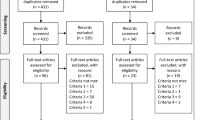Abstract
This study examined the role of religious and nonreligious cognitive-behavioral coping in a sample of 61 chronic pain patients from a midwestern pain clinic. Participants described their chronic pain and indicated their use of religious and nonreligious cognitive-behavioral coping strategies. Results supported a multidimensional conceptualization of religious coping that includes both positive and negative strategies. Positive religious coping strategies were associated significantly with positive affect and religious outcome after statistically controlling for demographic variables. In contrast, measures of negative religious coping strategies were not associated significantly with outcome variables. Several significant associations also were found between nonreligious cognitive-behavioral coping strategies and outcome variables. The results underscore the need for further research concerning the contributions of religious coping in adjustment to chronic pain. Practitioners of applied psychophysiology should assess their chronic pain patients' religious appraisals and religious coping as another important stress management strategy.
Similar content being viewed by others
REFERENCES
Aldwin,C.M.(1994).Stress,coping,and development.New York: Guilford Press.
Ashby,J.S.,& Lenhart,R.S.(1994).Prayer as a coping strategy for chronic pain patients.Rehabilitation Psychology,39,205–209.
Bulman,R.J.,& Wortman,C.B.(1977).Attributions of blame and coping in the "real world":Severe accident victims react to their lot.Journal of Personality and Social Psychology,35,351–363.
Bush,E.G.,& Pargament,K.I.(1997).Family coping with chronic pain.Families,Systems &Health,15,147–160.
Christensen,A.J.(1994).Cognitive distortion and depression in chronic pain:Association with diagnosed dis-orders.Journal of Consulting and Clinical Psychology,62,195–198.
Flor,H.,& Turk,D.C.(1985).Chronic illness in an adult family member:Pain as a prototype.In D.C.Turk & R.D.Kerns (Eds.),Health,illness and families:A life span perspective(pp.255–278).New York: Wiley.
Folkman,S., Lazarus,R.S., Gruen,R.J.,& DeLongis,A.(1986).Appraisal,coping,health status,and psycho-logical symptoms.Journal of Personality and Social Psychology,50,571–579.
Folkman,S., Moskowitz,J.T., Ozer,E.M.,& Park,C.L.(1995).Positive meaningful events and coping in the context of HIV/AIDS.Paper presented at the Annual Meeting of the American Psychological Association.
Gil,K.M., Abrams,M.R., Phillips,G.,& Keefe,F.J.(1989).Sickle cell disease pain:Relation of coping strategies to adjustment.Journal of Consulting and Clinical Psychology,57,725–731.
Grevengoed,N.(1985).Attributions for death:An examination of the role of religion and the relationship between attributions and mental health.Unpublished master's thesis,Bowling Green State University, Bowling Green, OH.
Hanson,R.W.,& Gerber,K.E.(1990).Coping with chronic pain:A guide to patient self-management.New York: Guilford Press.
Hoge,D.R.(1996).Religion in America:The demographics of belief and affiliation.In E.P.Shafranske (Ed.), Religion and the clinical practice of psychology(pp.21–41).Washington,DC: American Psychological Association.
Jenkins,R.A.,& Pargament,K.I.(1988).Cognitive appraisals in cancer patients.Social Science and Medicine, 26,625–633.
Jensen,M.P., Turner,J.A., Romano,J.M.,& Karoly,P.(1991).Coping with chronic pain:A critical review of the literature.Pain,47,249–283.
Keefe,F.J.(1992).The coping strategies questionnaire,Unpublished manuscript.Duke University Medical Center, Pain Management Program, Durham,NC.
Keefe,F.J.,& Dolan,E.(1986).Pain behavior and pain coping strategies in low back pain and myofascial pain dysfunction syndrome patients.Pain,24,49–56.
Keefe,F.J., Caldwell,D.S., Queen,K.T., Gil,K.M., Martinez,S., Crisson,J.E., Ogden,W.,& Nunley,J.(1987).Pain coping strategies in osteoarthritis patients.Journal of Consulting and Clinical Psychology,55,208–212.
Larson,D.B.,& Larson,S.S.(1994).The forgotten factor in physical and mental health:What does the research show?Rockville,MD:National Institutes for Healthcare Research.
Lazarus,R.S.,& Folkman,S.(1984).Stress,appraisal,and coping.New York: Springer.
Pargament,K.I.(1990).God help me:Toward a theoretical framework of coping for the psychology of religion. Research in the Social Scientific Study of Religion,2,195–224.
Pargament,K.I.(1997).The psychology of religion and coping:Theory,research,and practice.New York: Guilford Press.
Pargament,K.I.,& Sullivan,M.S.(1981).Examining attributions of control across diverse personal situations: A psychological perspective.Paper presented at the American Psychological Association,Los Angeles,CA.
Pargament,K.I., Ensing,D.S., Falgout,K., Olsen,H., Reilly,B., Van Haitsma, K.,& Warren,R.(1990).God help me:(I):Religious coping efforts as predictors of the outcomes to significant negative life events.American Journal of Community Psychology,18,793–824.
Pargament,K.I., Ishler,K., Dubow,E.F., Stanik,P., Rouiller,R., Crowe,E.P., Cullman,E.P., Albert,M., & Royster,B.J.(1994).Methods of religious coping with the Gulf War:Cross sectional and longitudinal analyses.Journal for the Scientific Study of Religion,33,347–361.
Pargament,K.I., Smith,B.,& Koenig,H.(1996).Religious coping with the Oklahoma City bombing:The brief RCOPE.Paper presented at the American Psychological Association,Toronto.
Poloma,M.M.,& Gallup,G.H.,Jr.(1991).Varieties of prayer:A survey report.Philadelphia: Trinity Press International.
Rosensteil,A.K.,& Keefe,F.J.(1983).The use of coping strategies in chronic low back pain patients:Relationship to patient characteristics and current adjustment.Pain,17,33–44.
Smith,T.W., O'Keeffe,J.L.,& Christensen,A.J.(1994).Cognitive distortion and depression in chronic pain: Association with diagnosed disorders.Journal of Consulting and Clinical Psychology,62,195–198.
Tix,A.P.,& Frazier,P.A.(1998).The use of religious coping during stressful life events:Main effects,moderation, and mediation.Journal of Consulting and Clinical Psychology,66,411–422.
Turner,J.A.,& Clancy,S.(1986).Strategies for coping with chronic low back pain:Relationship to pain and disability.Pain,24,355–364.
Watson,D., Clark,L.A.,& Tellegen,A.(1988).Development and validation of brief measures of positive and negative affect:The PANAS scales.Journal of Personality and Social Psychology,54,1063–1070.
Author information
Authors and Affiliations
Rights and permissions
About this article
Cite this article
Bush, E.G., Rye, M.S., Brant, C.R. et al. Religious Coping with Chronic Pain. Appl Psychophysiol Biofeedback 24, 249–260 (1999). https://doi.org/10.1023/A:1022234913899
Issue Date:
DOI: https://doi.org/10.1023/A:1022234913899




